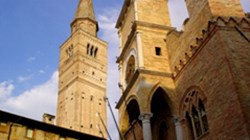
Italy
Vision underpinning the plan
The SUMP of Pordenone is called “Mobility System Project” and its key factors are:
- Satisfy population needs in favour of a more sustainable mobility
- Increase city liveability levels
- Reduce levels of air and noise pollution
- Reduce energy consumptions for mobility purposes
- Enhance transport measures for safety and security.
SUMP actions concern specifically:
- Implementation of new policies (i.e. enlarging restricted traffic zones, creation of green areas, new parking lots management, traffic monitoring, info-mobility, etc.)
- Renovation of the so-called ring (one-way road running around the city center)
- Improvement of road security, in particular for weak road users
- Planning new and alternative roads and itineraries to reduce traffic
- Study of new safety measures for roads and bike lanes
- Raising awareness in children about different mobility habits and implementing new pedibus (walk to school) and bicibus (cycle to school) schemes
- optimization of existing road infrastructures and transport networks in favour of more sustainable mobility such as bike and public transport
- Bike lanes extension, and update of the “Biciplan”
- Targeted measures on public transport, whether possible, in order to increase the capacity and number of users
- Promotion of shared and individual journeys such as car-pooling, etc.
- Incentive to use low polluting vehicles
- Monitoring urban area livability for a better quality of city life.


Long-term strategic objectives
A new city bypass in the southern part of Pordenone will complete the roads infrastructure. Other interventions will concern extension and requalification of other sections. Following the SUMP guidelines, the city parking spots will be increased and reorganized, through the creation of three parking lots in strategic points of the city:
Exhibition Center: 720 parking spots
Meduna Shopping Mall: 200 parking spots
City hospital: 400 parking spots.
The city will also be improved with a network of uninterrupted, direct and marked bike paths, structured in a circular route, the CicloRing, and a number of external paths. The trails will be organized into a BiciPlan creating a series of routes available for daily commuting. In addition, measures are envisaged to promote the use of soft mobility, such as the ability to park the bike in the parking lots close to facilities.
With this reorganization, it has been estimated that 820 users/hour would use bikes instead of cars. The reorganized infrastructure and the suggested intermodal mobility will allow a reorganization of the traffic in the city center. It also would provide the creation of new pedestrian areas, usually accompanied by environmental and urban recovery projects. Finally, within a long-term horizon, it would be possible to influence a wider area of intervention, actively involving other surrounding towns.
Mid-term goals
In the mid-term scenario intermodal mobility is the focus, promoting bike transport and soft mobility. Moreover, in order to improve the traffic and secure an existing major arterial road connecting the city from east to west, the SUMP proposes the construction of nine roundabouts. In the suburban areas, new 30 km/hour zones will be introduced. The pedestrian zones in the city center will allow a urban renovation, more enjoyable to citizens and visitors, without necessarily making changes to traffic and roads. These interventions, generally accompanied by environmental improvement measures, are therefore more favorably received than the enlargement of the restricted traffic zones.
Main implementation features
Context analysis
Private transport: automatic counting of traffic flows in 24 sections, and 2,300 motivational interviewing;
Analysis of the stop: counting machines in multi-storey structures and hourly analysis in areas related to the city center (day and night);
Public transport: the data provided by the Province; counts climbed and descended the local public transport (411 interviews) and the station (260 interviews);
Interviews with citizens: in particular traders / artisans (393 employees interviewed 149 business) and pedestrians (302 interviews);
Cycling: automatic counting of flow paths on the cycle network and urban road, the investigation on the propensity to cycling (1,245 interviews distributed in the different polarity of the city).
Monitoring and evaluation procedures
Expected results of actions undertaken within the SUMP can be seen by comparing the current situation with designed scenarios. Thanks to the program EMISMOB, aimed at quantifying the consumption and emissions of pollutants, it is possible to know exactly the amount of fuel consumed by passing vehicles, and the amount of emissions (NOx: oxides of nitrogen and their mixtures, CO: carbon monoxide, PM10: Particulate Matter, SPM: suspended particulate matter, CO2: carbon dioxide, N2O: nitrogen monoxide, CH4: methane), within a specific time frame, circulating vehicles and their speed.
Seen the current situation of mobility in the city of Pordenone, referred to the hour of the morning rush hour (7:30 to 8:30), through the form EMISMOB, the current fuel consumption and pollutant gas emissions have been quantified. In the SUMP is reported in tabular form the overall fuel consumption and emissions of major pollutants caused by vehicular mobility in the current scenario, the scenario of immediate implementation, medium-term and long-term. The data refer to the whole Pordenone road network, for a total of 380 km. A macro assessment on the consequences of the emission system of the area inside the Ring (about 26.5 kilometers) results in a reduction between 6% and 8%.